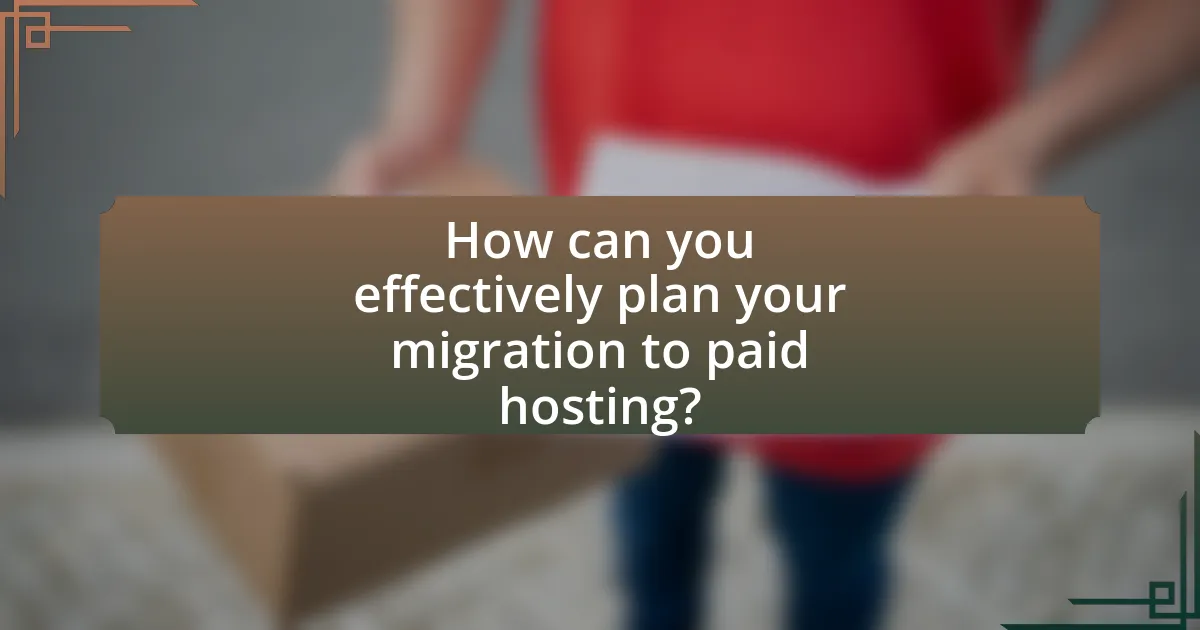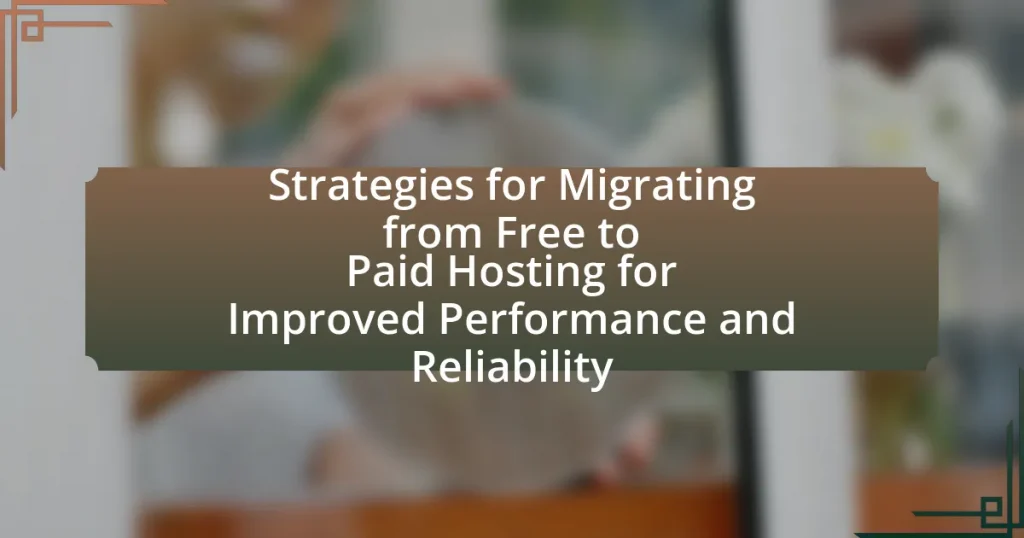The article focuses on strategies for migrating from free to paid hosting to enhance website performance and reliability. Key considerations for this transition include evaluating performance needs, budget constraints, data security, and customer support options. It highlights the advantages of paid hosting, such as improved loading times, uptime guarantees, and dedicated resources, while also addressing the migration process, potential challenges, and best practices for post-migration maintenance. Additionally, the article emphasizes the importance of ongoing performance monitoring and continuous improvement strategies to ensure optimal hosting outcomes.

What are the key considerations for migrating from free to paid hosting?
Key considerations for migrating from free to paid hosting include evaluating performance needs, assessing budget constraints, ensuring data security, and understanding customer support options. Performance needs dictate the required server resources, as free hosting often lacks the speed and reliability necessary for growing websites. Budget constraints must be analyzed to determine the most cost-effective hosting plan that meets those performance needs. Data security is crucial, as paid hosting typically offers better protection against breaches and data loss compared to free services. Lastly, customer support options should be considered, as paid hosting often provides more responsive and knowledgeable assistance, which is vital for resolving issues quickly.
Why should you consider upgrading to paid hosting?
Upgrading to paid hosting is essential for enhanced performance and reliability. Paid hosting services typically offer faster loading times, increased uptime guarantees, and better customer support compared to free hosting options. For instance, studies show that websites on paid hosting can achieve up to 99.9% uptime, while free hosting often experiences frequent downtimes. Additionally, paid hosting plans usually provide more resources, such as bandwidth and storage, which are crucial for handling higher traffic volumes effectively. This ensures a smoother user experience and can positively impact search engine rankings, as site speed and reliability are key factors in SEO.
What performance improvements can be expected from paid hosting?
Paid hosting typically offers significant performance improvements over free hosting, including faster loading times, increased uptime, and better resource allocation. These enhancements stem from dedicated server resources, optimized infrastructure, and advanced technologies that paid hosting providers implement. For instance, paid hosting often includes features like Content Delivery Networks (CDNs) and caching mechanisms, which can reduce latency and improve site speed. Additionally, paid plans generally provide higher bandwidth and storage limits, allowing for better handling of traffic spikes and larger data loads. According to a study by Google, a one-second delay in page load time can lead to a 20% decrease in conversions, highlighting the importance of performance in user experience and business outcomes.
How does paid hosting enhance reliability compared to free options?
Paid hosting enhances reliability compared to free options by providing dedicated resources, superior uptime guarantees, and professional support. Paid hosting services typically allocate specific bandwidth and storage to each user, reducing the risk of slow performance or downtime caused by resource sharing, which is common in free hosting. For instance, many paid hosting providers offer uptime guarantees of 99.9% or higher, ensuring that websites remain accessible to users. Additionally, paid hosting often includes 24/7 customer support, allowing for quick resolution of issues that could affect website reliability. In contrast, free hosting services may lack these features, leading to increased downtime and performance issues.
What factors should influence your choice of paid hosting provider?
When choosing a paid hosting provider, key factors include reliability, performance, customer support, pricing, and scalability. Reliability is crucial as it ensures minimal downtime; for instance, a provider with a 99.9% uptime guarantee is preferable. Performance is influenced by server speed and resources, which directly affect website loading times; faster servers can improve user experience and SEO rankings. Customer support is vital for resolving issues quickly; providers offering 24/7 support through multiple channels are more favorable. Pricing should align with your budget while considering the features offered; competitive pricing often includes essential services like backups and security. Lastly, scalability is important for future growth; a provider that allows easy upgrades to higher plans ensures your website can grow without significant disruptions.
How do pricing models differ among hosting providers?
Pricing models among hosting providers vary significantly, primarily in structure, features, and billing cycles. Some providers offer tiered pricing based on resource allocation, such as bandwidth and storage, while others may use a pay-as-you-go model that charges based on actual usage. Additionally, some hosting services provide flat-rate pricing for specific plans, which can include bundled features like domain registration and SSL certificates.
For instance, shared hosting typically has lower costs due to resource sharing, while dedicated hosting commands higher prices due to exclusive resource allocation. According to a 2022 report by HostingAdvice, the average cost of shared hosting ranges from $2.75 to $10 per month, while dedicated servers can start at $80 and go up to several hundred dollars monthly. This illustrates the broad spectrum of pricing models and their correlation with the level of service and resources provided.
What features should you prioritize when selecting a paid hosting plan?
When selecting a paid hosting plan, prioritize features such as uptime reliability, customer support, scalability, and security. Uptime reliability is crucial, as a hosting service with at least 99.9% uptime ensures your website remains accessible, which is supported by industry standards. Customer support should be available 24/7 through multiple channels, as timely assistance can resolve issues quickly, enhancing user experience. Scalability allows your hosting plan to grow with your website, accommodating increased traffic without performance degradation. Security features, including SSL certificates and regular backups, protect your data and enhance trustworthiness, which is essential for maintaining user confidence.

How can you effectively plan your migration to paid hosting?
To effectively plan your migration to paid hosting, start by assessing your current website needs, including traffic, storage, and performance requirements. This assessment allows you to choose a hosting plan that aligns with your specific demands, ensuring improved performance and reliability. Next, create a detailed migration timeline that includes backup procedures, DNS changes, and testing phases to minimize downtime. Additionally, communicate with your users about the migration to manage expectations. Research shows that a well-structured migration plan can reduce potential issues by up to 70%, as highlighted in the study by HostingAdvice.com, which emphasizes the importance of preparation in successful hosting transitions.
What steps are involved in the migration process?
The migration process involves several key steps: planning, preparation, execution, and testing. First, planning includes assessing current resources and determining the requirements for the new hosting environment. Next, preparation involves backing up data, selecting a suitable paid hosting provider, and configuring the new environment. Execution follows, where the actual transfer of files, databases, and applications occurs. Finally, testing ensures that the migrated site functions correctly in the new environment, verifying performance and reliability. Each of these steps is crucial for a successful migration from free to paid hosting, ensuring improved performance and reliability.
How do you prepare your website for migration?
To prepare your website for migration, conduct a comprehensive backup of all website files and databases. This ensures that you have a complete copy of your current site, which is crucial for restoring it in case of any issues during the migration process. Additionally, audit your website for broken links, outdated content, and any necessary updates to plugins or themes, as this will help streamline the transition and improve performance on the new hosting platform. Furthermore, create a detailed migration plan that outlines each step of the process, including timelines and responsibilities, to ensure a smooth transition.
What tools can assist in the migration process?
Tools that can assist in the migration process include website migration plugins, cloud migration services, and database migration tools. Website migration plugins, such as Duplicator and All-in-One WP Migration, facilitate the transfer of website files and databases with minimal downtime. Cloud migration services like AWS Migration Hub and Google Cloud Migrate provide comprehensive solutions for moving applications and data to cloud environments, ensuring scalability and reliability. Database migration tools, such as MySQL Workbench and SQL Server Migration Assistant, streamline the process of transferring databases, maintaining data integrity and minimizing errors. These tools are widely recognized for their effectiveness in simplifying the migration process and enhancing overall performance.
What potential challenges might arise during migration?
Potential challenges during migration from free to paid hosting include data loss, downtime, and compatibility issues. Data loss can occur if backups are not properly managed or if files are corrupted during the transfer process. Downtime may arise due to DNS propagation delays or server configuration errors, impacting website accessibility. Compatibility issues can emerge if the new hosting environment differs significantly from the previous one, leading to potential functionality problems with applications or databases. These challenges highlight the importance of thorough planning and testing before executing the migration to ensure a smooth transition.
How can you minimize downtime during the transition?
To minimize downtime during the transition from free to paid hosting, implement a phased migration strategy. This approach allows for gradual transfer of data and services, reducing the risk of complete service interruption. For instance, by migrating non-critical components first, you can test the new environment while keeping the main services operational. Additionally, utilizing a temporary domain or subdomain for testing can ensure that the primary site remains accessible. According to a study by the HostingAdvice team, phased migrations can reduce downtime by up to 70% compared to a full cutover approach, demonstrating the effectiveness of this strategy.
What are common pitfalls to avoid when migrating?
Common pitfalls to avoid when migrating include inadequate planning, data loss, and neglecting to test the new environment. Inadequate planning can lead to unforeseen issues, such as downtime or compatibility problems, which can disrupt services. Data loss often occurs if backups are not properly created or verified before migration, resulting in permanent loss of critical information. Additionally, neglecting to test the new environment can result in performance issues or bugs that affect user experience. According to a study by the Cloud Industry Forum, 70% of organizations that fail to plan adequately for migration experience significant operational disruptions.

What best practices should you follow post-migration to ensure optimal performance?
To ensure optimal performance post-migration, regularly monitor server performance metrics such as CPU usage, memory utilization, and response times. This practice allows for the identification of bottlenecks and resource allocation issues that may arise after migration. Additionally, implementing caching mechanisms, such as server-side caching or content delivery networks (CDNs), can significantly enhance load times and reduce server strain. Regularly updating software and plugins is crucial, as outdated components can lead to security vulnerabilities and performance degradation. Furthermore, conducting routine backups and testing recovery processes ensures data integrity and minimizes downtime in case of failures. These practices collectively contribute to maintaining high performance and reliability in a paid hosting environment.
How can you monitor the performance of your new hosting environment?
To monitor the performance of your new hosting environment, utilize performance monitoring tools such as New Relic, Datadog, or Google Cloud Monitoring. These tools provide real-time insights into server response times, uptime, and resource utilization, allowing you to identify bottlenecks and optimize performance. For instance, New Relic offers detailed application performance monitoring, which can help pinpoint slow transactions and errors, while Google Cloud Monitoring integrates seamlessly with Google Cloud services to track metrics and logs. Regularly reviewing these metrics ensures that your hosting environment operates efficiently and meets your performance expectations.
What metrics should you track to assess hosting performance?
To assess hosting performance, track metrics such as uptime, response time, bandwidth usage, and server load. Uptime measures the percentage of time the server is operational, with a target of 99.9% or higher indicating reliability. Response time gauges how quickly the server processes requests, ideally under 200 milliseconds for optimal user experience. Bandwidth usage reflects the amount of data transferred, which should align with your hosting plan to avoid throttling. Server load indicates the amount of processing power being used, with lower values suggesting better performance. Monitoring these metrics provides a comprehensive view of hosting effectiveness and helps identify areas for improvement.
How can you optimize your website for better speed and reliability?
To optimize your website for better speed and reliability, migrate from free hosting to a paid hosting service that offers dedicated resources and improved server performance. Paid hosting typically provides faster loading times due to better hardware, optimized server configurations, and reduced downtime, which enhances overall reliability. For instance, a study by HostingAdvice found that websites on paid hosting plans load up to 50% faster than those on free plans, significantly impacting user experience and search engine rankings. Additionally, implementing a Content Delivery Network (CDN) can further enhance speed by distributing content across multiple servers globally, reducing latency for users regardless of their location.
What ongoing maintenance is required for your paid hosting?
Ongoing maintenance for paid hosting includes regular software updates, security monitoring, and performance optimization. Software updates are essential to ensure that the hosting environment remains secure and compatible with the latest technologies. Security monitoring involves checking for vulnerabilities and implementing measures to protect against threats, which is crucial given that 43% of cyberattacks target small businesses. Performance optimization includes monitoring server load and response times to ensure that the website operates efficiently, which can significantly impact user experience and search engine rankings.
How often should you review your hosting plan and performance?
You should review your hosting plan and performance at least every six months. Regular reviews help ensure that your hosting solution meets your current needs, especially as website traffic and resource demands change. According to a study by HostingAdvice, 70% of businesses that regularly assess their hosting plans report improved website performance and user satisfaction. This frequency allows you to identify any potential issues, evaluate new hosting options, and make necessary adjustments to optimize performance and reliability.
What strategies can you implement for continuous improvement?
To implement continuous improvement strategies, organizations should adopt a systematic approach that includes regular performance assessments, feedback loops, and iterative processes. Regular performance assessments involve analyzing key performance indicators (KPIs) to identify areas needing enhancement, while feedback loops ensure that insights from stakeholders are integrated into decision-making. Iterative processes, such as Agile methodologies, allow for incremental changes and adaptations based on real-time data and user feedback. Research indicates that companies employing these strategies can achieve a 30% increase in efficiency and a 25% reduction in operational costs, demonstrating the effectiveness of continuous improvement in enhancing overall performance and reliability.
What are the top tips for a successful transition to paid hosting?
To successfully transition to paid hosting, first, choose a reliable hosting provider that meets your specific needs, such as bandwidth, storage, and customer support. Research shows that providers like Bluehost and SiteGround offer robust performance and excellent uptime, which are critical for maintaining website reliability. Next, back up your existing website data to prevent loss during migration; studies indicate that 30% of website owners experience data loss during transitions. Finally, test your website thoroughly after migration to ensure all functionalities work correctly, as 70% of users report issues if not properly tested.
